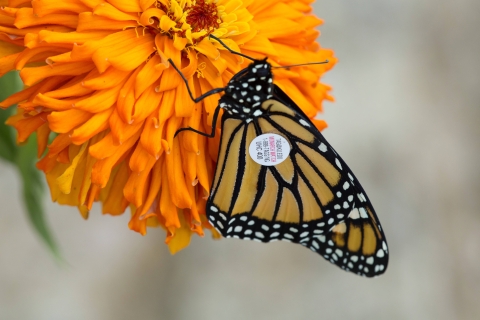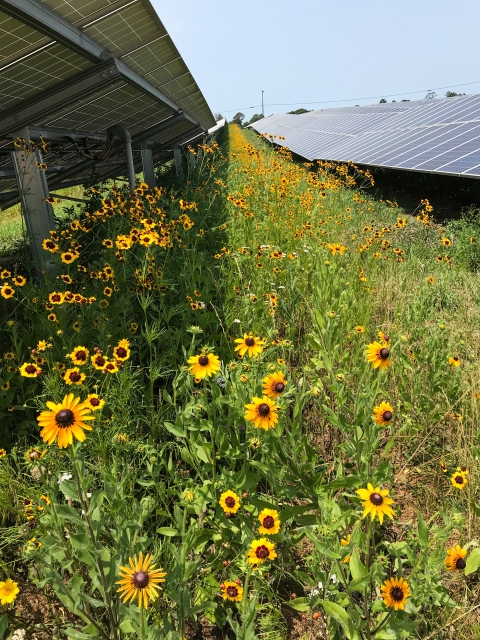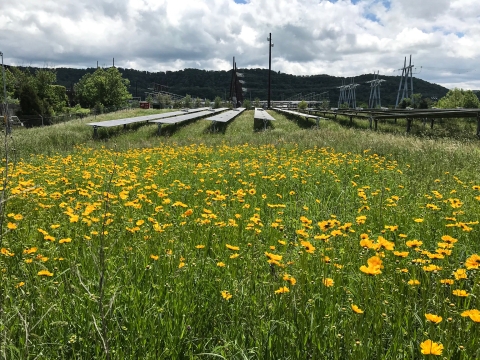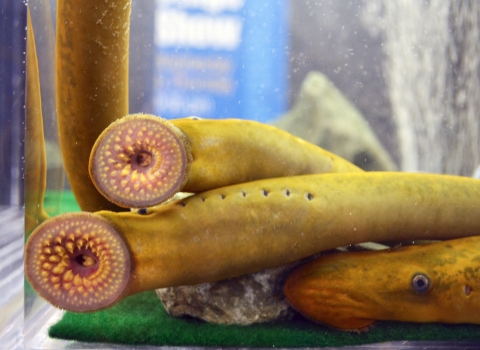As Bryan Tompkins approaches a solar power farm in Rowan County, North Carolina, his eyes are not on the solar panels – an increasingly common sight in North Carolina. His attention rests on the plants growing around the solar panel array.
Tompkins is a biologist in the U.S. Fish and Wildlife Service’s Asheville Field Office, where he reviews federally-funded or authorized projects for wildlife impacts under a variety of federal laws, including the Endangered Species Act – the goal being to at least minimize negative wildlife impacts, and hopefully provide some benefits.
“Several years ago, we saw increasing numbers of solar power projects coming into our office for environmental review,” said Tompkins. “While the solar farms provide renewable energy, the ground below and around the panels was basically a big lawn providing zero wildlife benefit, so we started thinking about how to change that.”
In reviewing solar farms, Tompkins and now-retired biologist Allen Ratzlaff concluded the simplest, most straightforward answer was to use that space for native plants that provide food or shelter for pollinators, a group of animals seeing widespread declines. The Service is currently considering the monarch butterfly, frosted elfin butterfly, regal fritillary butterfly, western bumble bee, and other pollinators for inclusion on the federal list of threatened and endangered species. In 2017, the rusty-patched bumble bee, last seen in North Carolina in 2007, was placed on the list – the first bumblebee ever listed.
According to the Solar Energy Industries Association, in 2018 North Carolina was second only to California in terms of solar power production, beating Arizona, Nevada, and Texas. In Tompkins’s mind, North Carolina was ripe to take advantage of this emerging power supply as a force for conserving pollinators.
In North Carolina, it’s typical to plant fescue or other non-native grasses on a solar farm, so one of the biggest hurdles Tompkins faced was a reluctance to commit resources to new land management strategies. The key, Tompkins pointed out, is focusing on maintenance costs, and for the solar power companies, one of the biggest expenses is mowing. Most non-native grasses require multiple mowings a month during the growing season and provide little to no pollinator habitat, whereas native, pollinator-friendly plants, once established, should only be mowed once or twice a year.
Through the environmental review process, Tompkins, and Gabriela Garrison, his counterpart with the N.C. Wildlife Resources Commission, worked with solar power companies individually. Eventually, these conversations led to the development, with The Nature Conservancy and the North Carolina Wildlife Federation, of the North Carolina Technical Guidance for Native Plantings on Solar Sites. The guidance includes information on pollinators, pollinator habitats, native seed mixes, and establishes guidelines for incorporating pollinator-friendly plantings into solar farms.
Tompkins and Garrison’s work with solar power companies emerged as others in the state, including the Asheville-based Bee City USA, were getting interested and active in pollinator conservation. This interest coalesced in the 2017 formation of the North Carolina Pollinator Conservation Alliance, a group of more than 20 organizations working to advance pollinator conservation. One project the alliance is working on is a scorecard that will enable solar farms to become certified as “pollinator-friendly.”
While the effort to conserve pollinators continues to build steam, Tompkins and Garrison still work with power companies to move the ground-level effort forward. Solar panels are installed on a tilt, and solar developers do not want plants growing in front of the lower edge of the panel, decreasing electricity production. Therefore, most pollinator plantings have been focused around the edge of solar farms and other areas away from the panels.
Two years ago, Strata Solar started an experiment with a new planting strategy. Mindful of keeping plants from shading the panels, they simply planted pollinator-friendly plants beneath the elevated end of the solar panels. Tompkins notes there has been an exponential increase in pollinator species and overall pollinator numbers at the site since the plantings. For Strata Solar, mowing and vegetation maintenance costs have been cut in half. The project is so successful Strata Solar agreed to plant five additional acres of pollinator habitat at the solar farm.
“Everyone has been very pleased with the outcome of the project so far,” said Tompkins. “It’s always a good sign when something works out so well the developer comes back and wants to do more.”
Though strides have been made in getting wildlife and pollinator practices implemented on solar farms, the work is far from over. There is still a long way to go before planting native pollinator plants on solar farms is the norm. Until then, Tompkins and Garrison continue working with developers and landowners to include native pollinator plants on their sites.
“It wasn’t necessarily a love of pollinators that got me working on this effort but an understanding and appreciation of the importance that pollinators play in our daily lives,” said Tompkins. “After reviewing these solar farm projects it was a no-brainer that planting native flowering plants and grasses could be done to benefit wildlife without burdening the developers.”







